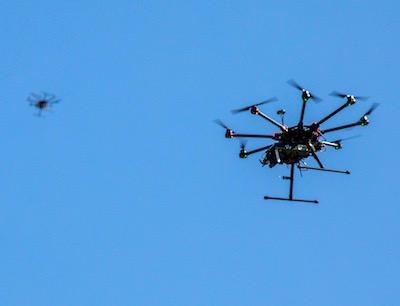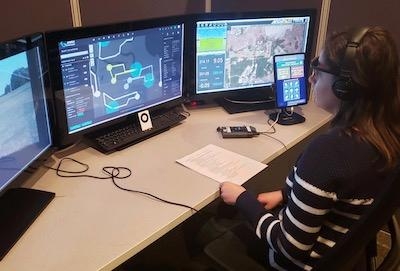Pathfinder Project Is Laying The Foundation For Safe Autonomous Flight In The National Air Space
Flying cars, drones delivering pizzas and a highway in the sky are scenes from science fiction, but they’re also visions of our very real future. At NASA's Langley Research Center in Hampton, VA, engineers are laying the foundation for safe autonomous flight in the national air space through a project called Pathfinder.

The goal of Pathfinder is to take separate Urban Traffic Management (UTM) projects and combine them into a single autonomous vehicle, then have that vehicle fly and communicate with other autonomous vehicles in the airspace.
“Pathfinder was conceived as a way to perform a graduation exercise for a lot of the UTM projects we developed over the years,” said Lou Glaab, assistant branch head for the Aeronautic Systems Engineering Branch in Langley's Engineering Directorate and Pathfinder project manager.
Part of that graduation exercise is the Independent Configurable Architecture for Reliable Operations of Unmanned Systems (ICAROUS). “We’re testing things like ICAROUS, which is an autonomous sense and avoid flight management system for unmanned systems, as well as Safe-2-Ditch, which is an autonomous safe landing or autonomous crash management system,” said Glaab.
Both of these technologies are critical going forward to enable Unmanned Aerial Systems (UAS) to have widespread access to the national airspace system. Combined, these systems will decrease the risk of a UAS flying near manned aircraft and over the people below.
To test this, researchers created incursions, where one drone flies too close to another, and then examined three different means of separation at the City Environment Range Testing for Autonomous Integrated Navigation (CERTAIN) range. “One is just manual, where the UTM operator has to get engaged and see that there’s an incursion coming and issue a command to maneuver out of the way,” said Glaab. “Another form of separation we looked at was called geo-fencing.”
Geo-fencing works like an invisible wall that can be placed around buildings, power lines and even around the flight path of another vehicle. “The software tells the intruder aircraft you have to honor the airspace of the ownership aircraft and drive around it to do what you need to do,” explained Glaab.
The third level of separation is autonomous sense and avoid, engaging another area of ICAROUS. This is used to figure out where a vehicle is going and to establish a route that will maintain a “well-clear separation” that’s needed. “To operate autonomously you need several capabilities, especially in the UAS domain,” said Swee Balachandran, research engineer. “You need to be able to make decisions to avoid other intruders in the air space, stay clear from no-fly zones, or inside a no-fly zone the UAV should know how to get out of it and to re-route itself around obstacles and no-fly areas.”

Balachandran also said that these functionalities are essential to operate autonomously without human intervention. That’s where ICAROUS comes in.
One of the key things in the development of ICAROUS was formal verification. “Every algorithm that you develop goes through a rigorous mathematical process and we have certain properties, and we ensure the algorithms satisfy those properties so that it is safety critical and you don’t see unwanted behaviors in flight,” said Balachandran.
As researchers conduct flight tests in the field, another piece of the pathfinder puzzle is taking place in a separate location. Similar to an air traffic control tower on a standard runway, NASA Langley’s Air Traffic Operations Lab (ATOL) is monitoring and making control decisions of active UAS flights. “Operators in the ATOL are observing their own vehicles and they’re also observing vehicles that are operating near their vehicle,” said Mike Politowicz, research aerospace engineer. “The goal is to make sure they maintain separation from all other vehicles. We give them some tasks to try and replicate what they would be doing in the real world.”
By having the operators complete tasks such as monitoring battery levels and observing all the surrounding traffic, researchers are able to collect data on the level of difficulty in managing urban traffic. “We want the participant to tell us if they trust the automation,” said Politowicz. “Their response to a certain scenario will give us insight into whether or not they felt comfortable with what the automation did or if they felt more comfortable just doing it manually.”
Originally these operators were going to be monitoring from the field. But after a unique communications link was created to connect the ATOL with the vehicles on the range, participants can now monitor the vehicles and traffic from afar. “We realized we could incorporate the ATOL into this and that involved getting a direct connection via LTE cellular link to the vehicles out in the field and also pulling in our traffic data, vehicle data and then a ground video feed from the CERTAIN range,” said Politowicz.
Politowicz also explained that this unique capability was a first step that researchers hope to expand on. By creating this link, they’ve opened the door to a lot of future research.
As project Pathfinder nears completion the team has moved from flights on the range to cross-center flights. Taking off from the roof of a centrally located building and then autonomously flying out to the range. “It’s exhilarating to watch a system that you worked on, developed the algorithms, and then to see it perform out there — it’s really a joyful experience,” said Balachandran.
“It was a great team,” said Glaab. “We had a very large team and everyone was putting in a lot of effort to bring this all together and that’s something I’ll remember going forward from this project.”
(Images provided with NASA news release)
 ANN's Daily Aero-Term (12.04.25): Cooperative Surveillance
ANN's Daily Aero-Term (12.04.25): Cooperative Surveillance ANN's Daily Aero-Linx (12.04.25)
ANN's Daily Aero-Linx (12.04.25) NTSB Prelim: Extra Flugzeugproduktions EA 300/SC
NTSB Prelim: Extra Flugzeugproduktions EA 300/SC Classic Aero-TV: The Bally Bomber - The All Time Ultimate Warbird Replica?
Classic Aero-TV: The Bally Bomber - The All Time Ultimate Warbird Replica? ANN's Daily Aero-Linx (12.05.25)
ANN's Daily Aero-Linx (12.05.25)




